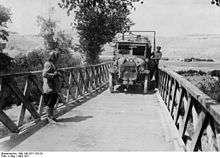Damia Bridge
The Damia Bridge (also Damiya) or Prince Muhammad Bridge (Arabic names), known in Israel as the Adam Bridge (Hebrew: גשר אדם), is a now closed bridge over the Jordan River between the West Bank and Jordan. It is about 35 kilometres (over 20 miles) north of Jericho and used to be the location of an Israeli border checkpoint. After 1991 it was used only for goods transported by truck between Israel and the West Bank on one side, and Jordan on the other, until some time between 2002 and 2005 during the Second Intifada, when it was closed by Israel due to security reasons and all traffic was moved to the Allenby Bridge border crossing.[1] As of 2014, on the Israeli side the bridge is part of a closed military area.
History

The site has been used as a crossing between the west and east banks of the Jordan since times immemorial, due to good access in both directions over the Far'a[2]/Tirzah Valley to the west and the Zarqa/Yabbok Valley to the east. Still visible are ruins of several consecutive bridges:[3] the stone bridge built by the Mamluk sultan Baibars in the 13th century, blown up by Haganah forces during Operation Markolet (known as the Night of the bridges) on the night of 16–17 June 1946; a British bridge built soon after, and a Jordanian one from the 1950s, both destroyed by the Israeli army during the 6-Day War of 1967. Right after the war, in August 1967, Israeli Minister of Defense Moshe Dayan allowed the uncontrolled traffic of goods between the Palestinians and Jordan using the ford of Damiya, as a way of avoiding the economic collapse of the West Bank and for avoiding Palestinian discontent, since the Israeli markets were not open yet to Palestinian produce. This was an element of what became known as the "policy of the open bridges".[4] In January 1968 Jordan built a prefabricated metal bridge to facilitate the trade connections to the West Bank. The bridge was open to both goods and people, but fighting due to the 1967-1970 War of Attrition led to the 1968 Battle of Karameh during which the bridge was damaged by Jordanian artillery who tried to prevent Israeli armour from passing. In 1969 the Jordanians blew up parts of this bridge,[5] but it was repaired at some later point. During the Black September events in 1970, the bridge was again closed for several days during the fighting between the Palestinians and the Jordanian army. The Jordanians repaired the bridge in early 1975 after it had been damaged by floods, and performed some amendments in 1976.[6] The Jordanian metal bridge still stands but is currently out of use. In 2014 the Palestinian authorities were negotiating with Jordan the possibilities of reopening traffic between the two sides.[7]
External links
- BibleWalks.com - Adam Bridge
- - Wikipedia page in Hebrew for picture, map
- - For the role of Damiya Bridge in the 1967 6-Day War
- - For the role of Damiya Bridge in the March 1968 Battle of Karameh
References
- ↑ "PA, Jordan working to reopen bridge Israel closed in 2005". Ma'an News Agency. 2014-02-13. Retrieved 2014-11-02.
- ↑ "The Wadi el-Far'a & Our Research Area". Calvin College, Grand Rapids, Michigan. Retrieved 2014-11-02.
- ↑ "Adam Bridge". BibleWalks.com. Retrieved 2014-11-02.
- ↑ "The Jordan Bridges". Israel Ministry of Foreign Affairs. 1994-02-01. Retrieved 2014-11-02.
- ↑ "Jordanians Blow Up Part of Damiya Bridge, 1 of 3 West Bank Links with Their State". Jewish Telegraphic Agency. 1969-01-08. Retrieved 2014-11-02.
- ↑ "1967 Israel Original old photograph, The Damia Bridge explosion; uses Hebrew Wikipedia information passed through Google Translate". eBay. 2014-11-02. Retrieved 2014-11-02.
- ↑ "PA, Jordan working to reopen bridge Israel closed in 2005". Ma'an News Agency. 2014-02-13. Retrieved 2014-11-02.
Coordinates: 32°6′9.45″N 35°32′6.19″E / 32.1026250°N 35.5350528°E